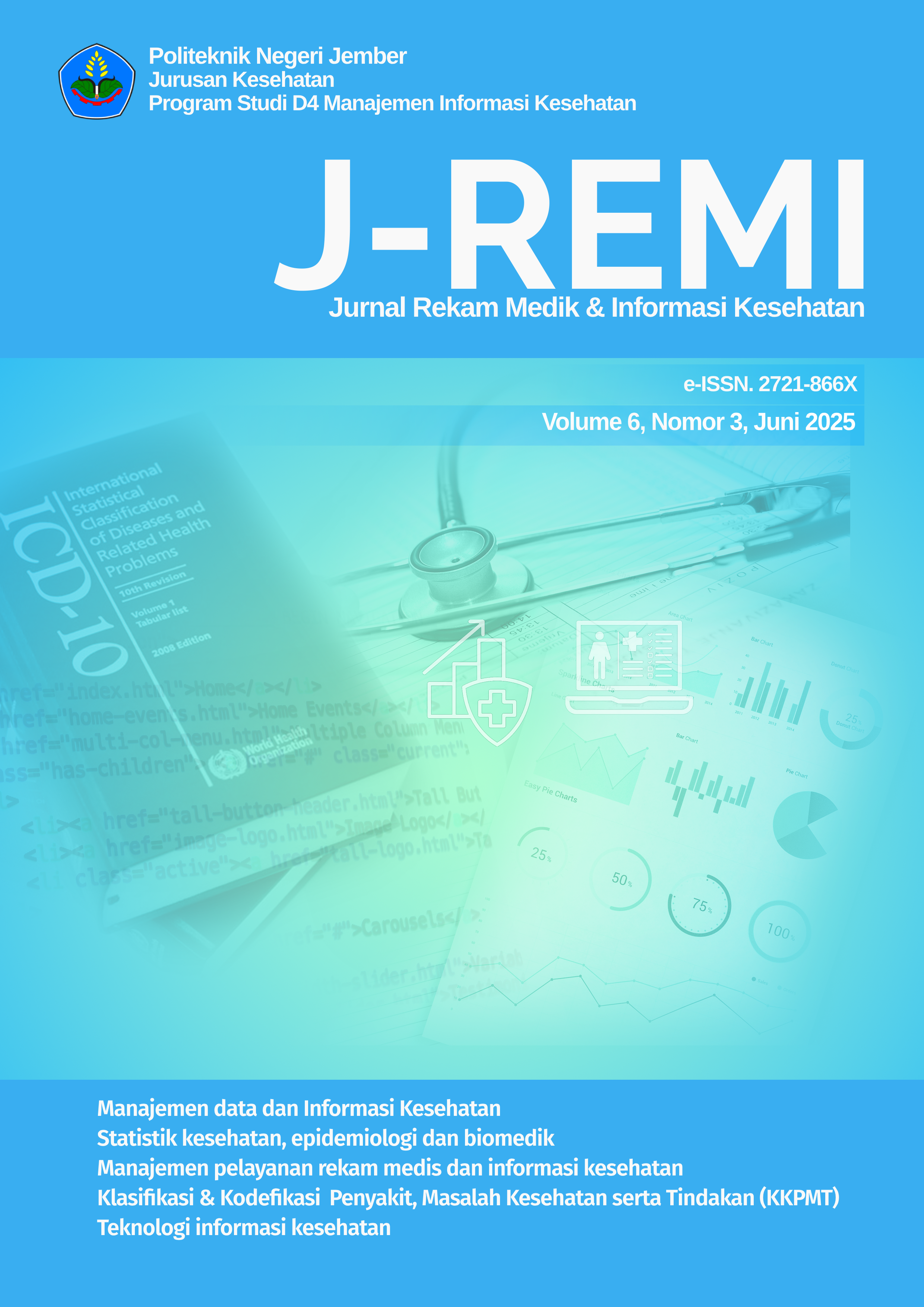Tinjauan Sistematis Terhadap Implementasi Rekam Medis Elektronik Pada Pelayanan Rawat Jalan
DOI:
https://doi.org/10.25047/j-remi.v6i3.5891Keywords:
Efficiency, Outpatient Services, Electronic Medical Records, Systematic ReviewAbstract
The implementation of Electronic Medical Records (EMR) in Indonesia presents a strategic opportunity to improve the quality and efficiency of healthcare services by optimizing access to medical information and strengthening coordination among healthcare professionals. However, its implementation still faces major challenges, particularly in terms of data security and workforce readiness. This study aimed to evaluate the benefits, challenges, and impacts of EMR adoption on medical practice and healthcare delivery. The research was conducted using a systematic literature review method with a PRISMA approach. A total of 4,475 articles were identified from four major databases: PubMed, Google Scholar, ScienceDirect, and Scopus. After screening titles, abstracts, and full texts, 10 articles met the inclusion criteria and were further analyzed. The findings indicated that EMR can accelerate access to patient information, enhance coordination among medical teams, and reduce the risk of documentation errors. This review suggests that EMR has significant potential to improve the efficiency, accuracy, and quality of outpatient services. However, the success of its implementation largely depends on technical readiness, human resource capacity, and infrastructure support. Further efforts should focus on improving digital literacy among healthcare workers, strengthening data security, and developing infrastructure to support the optimal implementation of EMR systems.
References
[1] D. Alammari, J. E. Banta, H. Shah, E. Reibling, and S. Talsania, “Use of Electronic Health Records and Quality of Ambulatory Healthcare,” Cureus, vol. 14, no. 10, pp. 1–14, Oct. 2022, doi: 10.7759/cureus.30343.
[2] T. Garrido, L. Jamieson, Y. Zhou, A. Wiesenthal, and L. Liang, “Effect of electronic health records in ambulatory care: retrospective, serial, cross sectional study,” BMJ, vol. 330, no. 7491, pp. 1–5, Mar. 2005, doi: 10.1136/bmj.330.7491.581.
[3] F. A. Rachmawati, G. Y. Sanjaya, and Firman, “Pengaruh implementasi rekam medis elektronik terhadap waktu tunggu rawat jalan reguler di RS Hermina Solo,” J. Manaj. Pelayanan Kesehat. (The Indones. J. Heal. Serv. Manag., vol. 26, no. 2, pp. 38–43, Aug. 2023, doi: 10.22146/jmpk.v26i2.8645.
[4] Kementerian Kesehatan Republik Indonesia, Peraturan Menteri Kesehatan Nomor 24 Tahun 2022 tentang Rekam Medis. Jakarta: Kementerian Kesehatan Republik Indonesia, 2022.
[5] J. N. Hamdani, M. W. Santi, E. Rachmawati, and Sabran, “Analisis Kesiapan penerapan Rekam Medis Elektronik di Rumah Sakit,” J. Penelit. Kesehat. “SUARA FORIKES,” vol. 13, no. November, pp. 82–91, 2022.
[6] H. Hendratno and E. Gunawan, “Efektivitas Penggunaan Rekam Medis Elektronik Terhadap Petugas Pelayanan Rawat Jalan IPET RSCM Kencana di RSUP Nasional Dr. Cipto Mangunkusumo,” J. Kesehat. Masy. Indones., vol. 2, no. 1, pp. 77–90, Nov. 2024, doi: 10.62017/jkmi.v2i1.2815.
[7] S. Albagmi, “The effectiveness of EMR implementation regarding reducing documentation errors and waiting time for patients in outpatient clinics: a systematic review,” F1000Research, vol. 10, pp. 1–18, Jun. 2021, doi: 10.12688/f1000research.45039.1.
[8] D. S. D. Anjani and Y. Yunengsih, “Pengaruh Penggunaan Rekam Medis Elektronik Terhadap Efektivitas Pelayanan Rawat Jalan di Rumah Sakit X,” J. Kesehat. dan Teknol. Medis, vol. 8, no. 7, pp. 22–32, 2024.
[9] H. Finnegan and N. Mountford, “25 Years of Electronic Health Record Implementation Processes: Scoping Review,” J. Med. Internet Res., vol. 27, pp. 1–15, Mar. 2025, doi: 10.2196/60077.
[10] D. K. Hidayat, Nurdin, R. Suyanto, and N. G. D. Putra, “The Effect of Electronic Medical Record and Service Time on Outpatient Satisfaction,” J. Manaj. dan Pemasar. Jasa, vol. 15, no. 2, pp. 213–226, 2022.
[11] T. Latipah, S. Solihah, and S. Setiatin, “Pengaruh Rekam Medis Elektronik Terhadap Peningkatan Efektivitas Pelayanan Rawat Jalan di Rumah Sakit X,” Cerdika J. Ilm. Indones., vol. 1, no. 10, pp. 1422–1434, Oct. 2021, doi: 10.36418/cerdika.v1i10.215.
[12] L. Raymond et al., “Improving performance in medical practices through the extended use of electronic medical record systems: a survey of Canadian family physicians,” BMC Med. Inform. Decis. Mak., vol. 15, no. 1, pp. 1–15, Dec. 2015, doi: 10.1186/s12911-015-0152-8.
[13] F. R. Ikawati, “Efektivitas Penggunaan Rekam Medis Elektronik Terhadap Peningkatan Kualitas Pelayanan Pasien di Rumah Sakit,” Ranah Res. J. Multidiscip. Res. Dev., vol. 6, no. 3, pp. 282–292, Mar. 2024, doi: 10.38035/rrj.v6i3.819.
[14] D. R. A. Tiorentap, “Manfaat Penerapan Rekam Medis Elektronik Di Negara Berkembang: Systematic Literature Review,” Indones. Heal. Inf. Manag. J., vol. 8, no. 2, pp. 69–79, 2020.
[15] R. Rendarti, “Faktor-Faktor yang Mempengaruhi Mutu Pelayanan Rekam Medis di Rumah Sakit,” Surya Med. J. Ilm. Ilmu Keperawatan dan Ilmu Kesehat. Masy., vol. 14, no. 2, pp. 59–65, Nov. 2019, doi: 10.32504/sm.v14i2.125.
[16] E. Wright et al., “Sharing Physician Notes Through an Electronic Portal is Associated With Improved Medication Adherence: Quasi-Experimental Study,” J. Med. Internet Res., vol. 17, no. 10, p. e226, Oct. 2015, doi: 10.2196/jmir.4872.
[17] H. Kavandi, Z. Al Awar, and M. Jaana, “Benefits, facilitators, and barriers of electronic medical records implementation in outpatient settings: A scoping review,” Healthc. Manag. Forum, vol. 37, no. 4, pp. 215–225, Jul. 2024, doi: 10.1177/08404704231224070.
[18] M. S. O’Brien, “Implementation of the EPIC Electronic Medical Record/Physician Order-Entry System,” J. Healthc. Manag., vol. 51, no. 5, pp. 338–343, 2006.
[19] N. N. Sari, D. H. Putra, N. Yulia, and D. Sonia, “Analisis Kesiapan Implementasi RME Rawat Inap dengan DOQ-IT di Rumah Sakit Port Medical Center,” J-REMI J. Rekam Med. dan Inf. Kesehat., vol. 5, no. 1, pp. 23–32, 2023, doi: https://doi.org/10.25047/j-remi.v5i1.4129.
[20] I. Sudirahayu and A. Harjoko, “Analisis Kesiapan Penerapan Rekam Medis Elektronik Menggunakan DOQ-IT di RSUD Dr. H. Abdul Moeloek Lampung,” J. Inf. Syst. Public Heal., vol. 1, no. 3, pp. 35–43, Sep. 2017, doi: 10.22146/jisph.6536.
[21] S. Siswati, T. Ernawati, and M. Khairunnisa, “Analisis Tantangan Kesiapan Implementasi Rekam Medis Elektronik di Puskesmas Kota Padang,” J. Kesehat. Vokasional, vol. 9, no. 1, pp. 1–16, Feb. 2024, doi: 10.22146/jkesvo.92719.
Downloads
Published
How to Cite
Issue
Section
License
Copyright (c) 2025 Anggraina Diastri, Rico Kurniawan

This work is licensed under a Creative Commons Attribution-ShareAlike 4.0 International License.






